Durability meets design when concrete takes center stage in your outdoor space. From textured finishes to stamped patterns and minimalist slabs, concrete patios offer endless potential for customization while remaining budget-friendly and low maintenance. Homeowners looking to update their backyard with modern appeal often turn to concrete for its versatility and clean aesthetic. Whether your goal is to carve out a cozy corner for evening relaxation or design a spacious area for entertaining, there’s a concrete solution that fits. This guide explores a variety of concrete patio ideas tailored to different styles, sizes, and needs—perfect for maximizing both function and curb appeal.
Multi-level concrete zones with built-in seating

Breaking up a patio into tiered zones can turn a flat space into a dynamic, functional outdoor environment. Multi-level concrete designs not only maximize use of uneven terrain but also create natural separations for lounging, dining, or entertaining. When integrated with built-in seating, the space becomes both practical and architectural, eliminating the need for bulky outdoor furniture. Clean-edged concrete benches with backrests or low parapets can double as planters or lighting bases, offering built-in utility without visual clutter.
Each level can feature varying textures—brushed for grip on stairs, smooth for seating, or exposed aggregate for visual interest. By playing with elevation, homeowners gain a versatile layout that adds interest without disrupting flow. It’s especially valuable in smaller yards or sloped plots, helping guide the eye and define purpose. For optimal results, drainage must be considered during design to prevent water pooling on lower tiers.
Integrating built-in seating with concrete zones also reduces long-term maintenance. There’s no upholstery to weather or store seasonally. Just solid, sculptural utility that holds up in all climates. For homeowners seeking durability and style without overcomplicating their outdoor layout, this approach delivers a balanced, modern aesthetic that blends function and form seamlessly.
Permeable concrete slabs for eco-friendly drainage
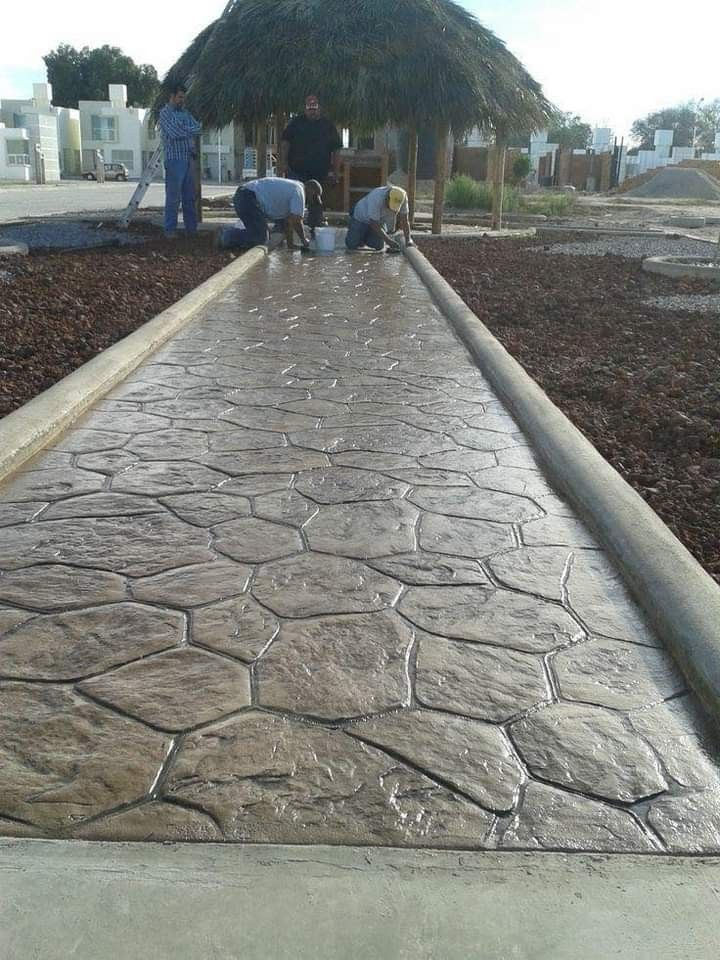
Tackling runoff issues starts with a surface that works with nature rather than against it. Permeable concrete slabs allow rainwater to filter through joints or porous material, helping to recharge groundwater instead of overwhelming storm drains. This eco-friendly solution is especially beneficial in regions prone to flooding or areas where water restrictions are enforced.
The concept blends environmental consciousness with curb appeal. Instead of sealed surfaces that trap water, permeable patios often incorporate open-joint patterns filled with gravel, grass, or moss, adding a natural softness to hardscaping. These slabs can be designed to suit modern or rustic aesthetics, offering flexibility in finish, shape, and layout.
Beyond sustainability, permeable systems reduce heat absorption, making the patio cooler during warmer months. They also help prevent surface cracking by allowing water to move freely underneath. Proper installation is key—layers of compacted gravel beneath the slabs ensure adequate drainage and structural support.
For homeowners looking to build responsibly without compromising on style, permeable concrete offers both performance and elegance. It’s a future-forward option that addresses environmental concerns while enhancing everyday livability. Whether paired with native landscaping or sleek edging, this choice reflects both personal taste and a mindful approach to outdoor design.
Stamped concrete mimicking natural textures
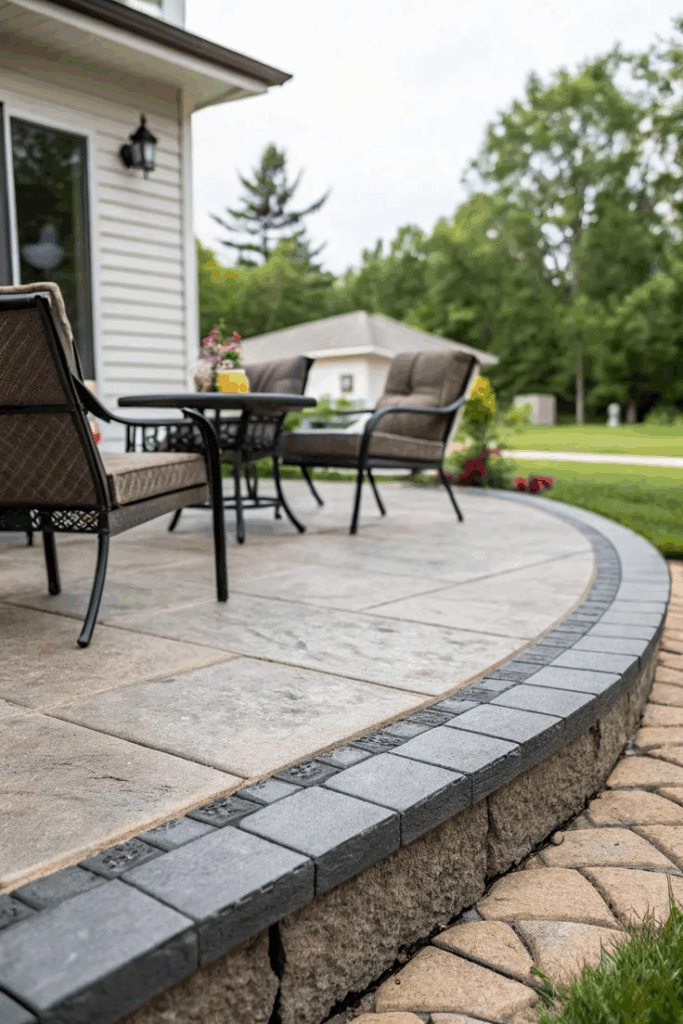
Giving concrete a textural twist can completely reshape its perception. Stamped finishes offer the visual appeal of materials like flagstone, brick, or wood—without the associated maintenance or cost. This method uses custom rubber molds pressed into freshly poured concrete, imprinting patterns and textures that mimic natural surfaces with impressive realism.
Color additives further enhance the illusion. Earthy tones replicate aged stone, while warm browns and tans create the look of timber decking. The results are not only visually convincing but also resilient underfoot. Unlike individual pavers or wood planks, stamped concrete doesn’t shift, warp, or invite weeds between cracks.
Ideal for high-traffic patios, pool decks, or garden walkways, this technique delivers consistent finishes across large areas. Sealing the surface protects it from stains and fading while adding a subtle sheen that enhances detail. Homeowners can tailor the pattern, scale, and pigment to suit traditional or modern aesthetics.
Stamped concrete offers long-term savings as it holds up well against sun exposure, freeze-thaw cycles, and regular foot traffic. It’s a low-maintenance way to achieve upscale texture and curb appeal—perfect for those seeking durability with design flexibility. From classic cobblestone to driftwood-inspired boards, the creative potential is vast.
Polished concrete for a sleek, modern look

Refined yet rugged, polished concrete delivers unmatched elegance with minimal fuss. This finish involves grinding down the surface until it reaches a smooth, reflective state—often compared to natural stone or terrazzo. It’s a favorite in modern architecture thanks to its clean lines, seamless continuity, and understated luxury.
Outdoor patios with polished concrete gain an urban-edge sophistication without sacrificing durability. The process densifies the surface, making it more resistant to stains, weathering, and abrasion. Applied sealers further guard against moisture, UV damage, and discoloration, helping the patio maintain its luster season after season.
Design options abound. Homeowners can choose varying levels of sheen, from satin to high-gloss, and even embed aggregates like marble chips or colored glass for visual interest. Border scoring, geometric cuts, or integrated lighting can add definition without disrupting the minimalist tone.
Polished concrete also reflects light efficiently, making small patios feel larger and brighter. For those who value both aesthetic clarity and structural strength, this surface delivers. It offers an ideal foundation for sleek furniture, sculptural planters, or integrated seating. Low-maintenance and highly durable, it strikes the perfect balance between artful presentation and practical functionality.
Painted or stenciled geometric “rug” designs
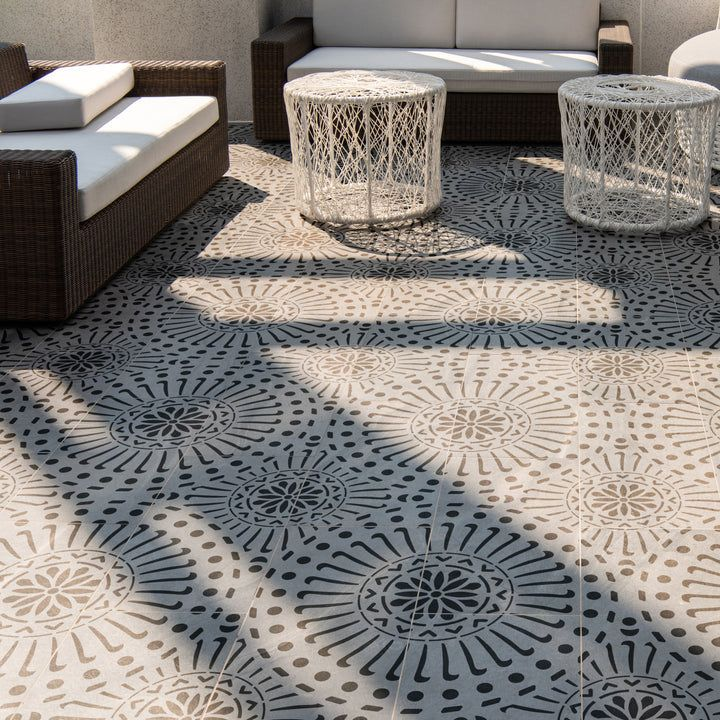
Transforming bare slabs into patterned focal points adds character without major renovations. Painted or stenciled geometric designs function like outdoor area rugs—framing furniture while injecting color and personality. Using specialized concrete paint, homeowners can craft repeating motifs, borders, or bold central medallions that anchor the space visually.
From Moroccan latticework to modern hexagons or mid-century chevrons, patterns can align with any décor style. The technique suits small patios especially well, breaking up monotonous expanses and directing the eye. It’s also budget-friendly, allowing for seasonal or stylistic updates with minimal effort.
Before applying designs, the surface must be cleaned and etched to ensure proper adhesion. Weather-resistant paints or concrete stains provide long-lasting color without peeling or fading. A protective sealant layer guards against foot traffic, moisture, and UV rays, keeping the design sharp over time.
This creative approach empowers homeowners to personalize their space without altering the structure. It’s particularly useful in rentals or low-budget makeovers where permanent changes aren’t feasible. A well-placed stencil pattern can define a dining area, lounge corner, or firepit zone—bringing style to function through simple artistic expression. For those craving flair without construction, this technique makes a bold yet approachable statement.
Sunken firepit area surrounded by smooth slabs

Lowering the ground level to form a sunken firepit zone introduces depth and drama to any outdoor layout. This recessed feature not only provides wind protection but also fosters an intimate atmosphere perfect for evening gatherings. Surrounded by smooth concrete slabs, the setup maintains a clean, structured edge that supports minimalist or contemporary styles.
The contrast between the sunken pit and raised patio enhances spatial dynamics, naturally drawing the eye inward. Smooth slabs around the perimeter offer both safety and style—eliminating trip hazards while acting as low walls or casual seating ledges. Heat-resistant materials ensure longevity, even with frequent fire usage.
Lighting can be subtly embedded into the surrounding slabs to define edges at night, while gravel or crushed stone fills the base for added texture and drainage. Paired with neutral-toned cushions or modular furniture, the setup becomes both inviting and practical.
This layout suits yards of all sizes, as the sunken design helps carve out zones without expanding the footprint. It’s a smart solution for homeowners seeking a focal point that balances aesthetics with utility. With durability built into every pour, the result is a weatherproof centerpiece that elevates outdoor lounging year-round.
Large-format slabs for minimalism and continuity
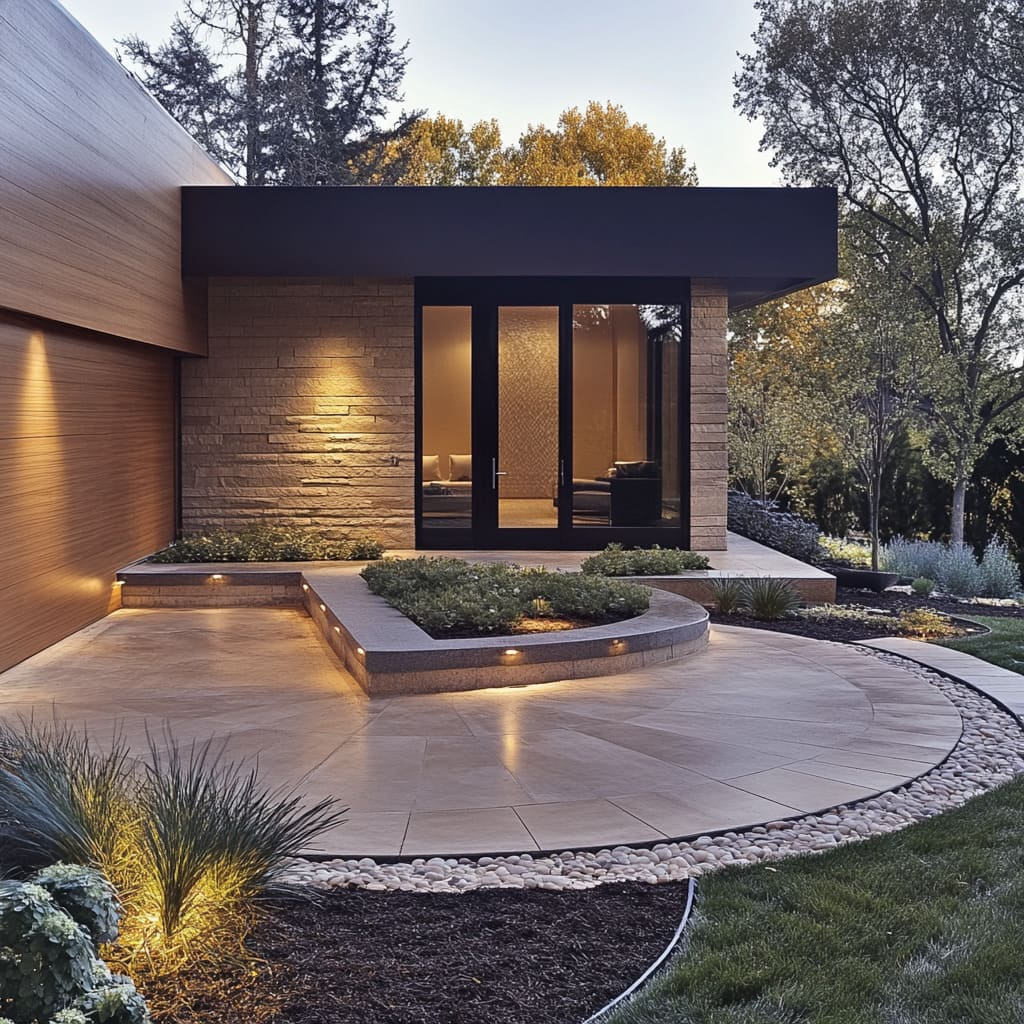
Scaling up slab size can make outdoor patios feel expansive and serene. Large-format concrete pavers reduce the number of grout lines or joints, offering visual continuity and a clean, modern appeal. Their sleek profile complements minimalist landscapes where form and proportion take center stage.
The simplicity of fewer cuts translates to fewer interruptions in both design and maintenance. Large slabs absorb less water at the joints, minimizing weed growth or erosion. This makes them ideal for high-use zones like dining terraces or open lounge areas. When paired with monochrome tones, the surface takes on a gallery-like presence that pairs beautifully with bold plants or sculptural furniture.
Installation does require careful planning—adequate subgrade support ensures the slabs don’t crack or shift. Edges can be framed with thin gravel seams or metal strips for definition without cluttering the look.
For homeowners who value subtle elegance, large-format concrete delivers a tailored foundation that feels refined yet grounded. Whether used as a seamless extension of indoor flooring or a crisp canvas for modern design, these oversized pieces offer a streamlined solution with maximum visual impact and long-term practicality.
Integrated LED lighting in concrete joints

Adding ambient lighting directly into a patio’s structure offers both function and visual sophistication. LED strips or nodes integrated into the joints between concrete slabs create subtle outlines that define pathways, seating zones, or architectural elements without external fixtures. This embedded lighting approach enhances usability after dark while preserving clean sightlines during the day.
Low-voltage, waterproof LED systems are ideal for outdoor use. They tuck neatly into grooves or custom channels poured into the concrete, minimizing exposure and reducing tripping hazards. Smart lighting controls or motion sensors can be included for added efficiency and customization.
The lighting effect is soft and directional, casting a glow that highlights textures, edges, and transitions between surfaces. When paired with smooth or polished finishes, the illumination becomes even more pronounced—perfect for entertaining or evening relaxation.
Installation should be planned during the design phase to accommodate wiring, drainage, and thermal expansion. A clear sealant helps protect both the concrete and lighting components.
For homeowners aiming to blend technology with design, integrated lighting delivers a polished solution that extends patio functionality into the night. It adds modern sophistication without the visual weight of freestanding fixtures or string lights.
Floating pavers over gravel base
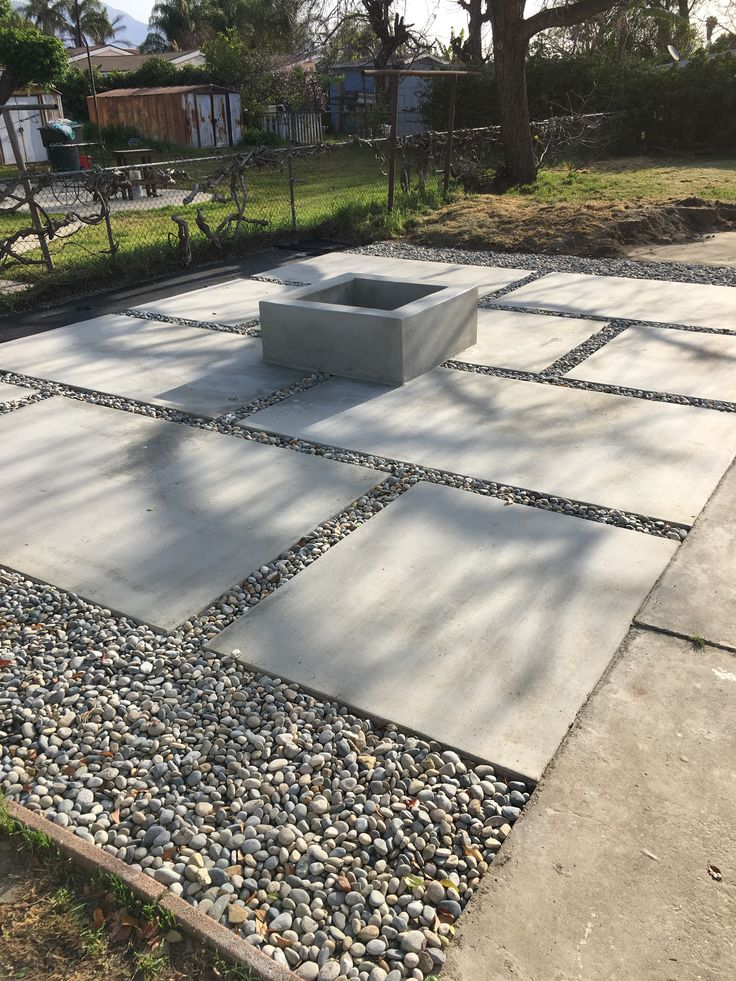
Suspended designs offer a lighter, more breathable take on traditional hardscaping. Floating concrete pavers laid over a gravel base create the illusion of hovering slabs, breaking up solid surfaces with negative space. This arrangement encourages natural drainage while visually softening the footprint.
The gravel layer underneath not only supports water filtration but also buffers expansion and movement—helping reduce cracking over time. Concrete pavers can be arranged in repeating patterns or staggered paths, creating a rhythm that feels intentional yet relaxed. The gaps allow surrounding soil and garden beds to breathe, making this setup well-suited for drought-tolerant or native landscapes.
Choosing rectangular or square slabs with precise edges sharpens the aesthetic, especially when paired with dark gravel or crushed stone. Weed-blocking fabric underneath maintains the minimalist vibe by discouraging growth between the joints.
This format is ideal for transitional spaces, like side yards, pool access paths, or dining patios with informal charm. It’s also a favorite among DIY homeowners, as the installation process is more forgiving than poured concrete. Floating pavers offer flexibility, adaptability, and a distinctly modern touch—all while embracing sustainability through smart drainage and thoughtful spacing.
Mixed-material inlays: combining tile, brick, or wood

Marrying textures within one surface can elevate an otherwise standard patio into a design feature. Mixed-material inlays involve embedding secondary materials like brick, tile, or wood into a concrete base, creating intentional contrast and framing. These accent bands or center insets provide a tactile and visual break from monotony while anchoring furniture or walkways.
Brick borders can echo the style of nearby architecture, lending warmth and familiarity. Decorative tiles add pops of pattern or color, perfect for Mediterranean or eclectic aesthetics. Inlaid wood strips, treated for weather resistance, bring natural softness that contrasts beautifully against cool concrete.
Precise planning is key—each material expands and contracts differently, so proper spacing and flexible grout are essential. The layout must also accommodate drainage without compromising design cohesion.
This approach offers creative freedom and adds high-end polish without resorting to fully tiled or decked surfaces. It’s ideal for homeowners who want a custom feel without committing to full-scale renovations. The result is a layered, intentional space that reflects personal taste while maintaining durability.
Inlays are also functional—serving as subtle visual cues for different zones or transitions within the patio. With thoughtful execution, the outcome is timeless and truly one-of-a-kind.
Covered concrete patio under a pergola or awning

Extending usability year-round, a covered concrete patio adds shade, shelter, and architectural definition. When paired with a pergola or awning, the concrete base becomes a functional foundation for outdoor dining, relaxing, or entertaining regardless of weather. Unlike wood decking, concrete resists rot, warping, and termite damage, offering long-term durability beneath any overhead structure.
The overhead cover can be tailored to the homeowner’s needs—slatted pergolas provide filtered light and vine support, while retractable awnings or polycarbonate roofs offer full weatherproofing. Together, the elements form a cohesive outdoor room that balances exposure with comfort.
Design flexibility is high. Concrete can be broom-finished for slip resistance, dyed to match exterior palettes, or stamped for added texture. Drainage should be considered carefully, ensuring water runoff from the cover doesn’t pool at the patio’s base.
This combination also expands opportunities for accessories like ceiling fans, pendant lighting, or hanging planters. It anchors the space both visually and practically—especially in open yards lacking built-in shelter. Whether framing an outdoor kitchen or a cozy lounge setup, this pairing delivers style and shelter in one coordinated layout. Homeowners benefit from a patio that feels both grounded and elevated, all while keeping maintenance low and comfort high.
Concrete countertop outdoor bar island

Outdoor kitchens gain significant utility and visual weight with the addition of a concrete bar island. Offering ample prep space, seating, and a central gathering point, this feature turns a simple patio into a full-function entertaining zone. Concrete’s heat resistance, durability, and customization potential make it a standout choice for counters exposed to the elements.
A poured-in-place or precast concrete slab can be shaped to fit the layout—whether linear, L-shaped, or curved. Color additives, embedded materials, and edge detailing allow for full personalization. Integrated sinks, cooktops, or under-counter storage can be added for maximum function.
Unlike stone or tile, concrete surfaces resist shifting and grout cracking. When sealed properly, they fend off stains from wine, oil, or citrus—common culprits in outdoor hosting. They also retain their sleek appearance without frequent upkeep.
Paired with stools and ambient lighting, the island becomes a hub that draws people in while keeping messes contained to one area. For homeowners seeking to extend indoor living into their backyard, this bar island offers a professional-grade feature that anchors the space in both style and substance.
It’s an investment in both design and convenience—ideal for frequent hosts or culinary creatives who enjoy outdoor gathering.
Reflective glass or mirror walls to widen space
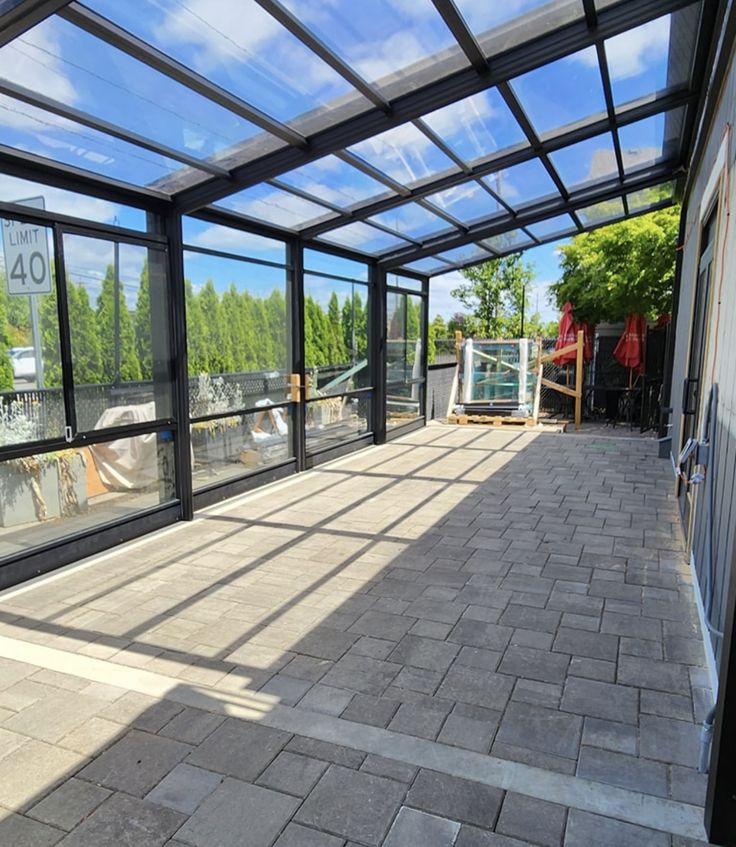
In smaller patio areas, visual expansion is just as valuable as functional furniture. Installing reflective glass or mirrored panels along one or more boundaries can make compact concrete patios feel significantly more spacious. These surfaces bounce light back into the space, creating an airy, open atmosphere even in shaded or enclosed yards.
The mirrored finish doesn’t need to be stark—bronzed or smoked tones can soften the effect while still amplifying depth. Framed panels integrated into concrete walls or freestanding structures maintain a sleek, modern aesthetic while minimizing clutter.
Positioning is key. Placing mirrors opposite greenery, sculptural elements, or water features doubles the visual impact without adding bulk. Regular maintenance is simple: occasional cleaning ensures clarity and shine, especially in exposed environments.
Beyond aesthetic benefits, reflective walls can also shield unwanted views or add privacy when strategically placed. Combined with smooth concrete flooring and minimalist furnishings, the setup becomes a sophisticated backdrop that maximizes limited square footage.
This design choice is especially effective in urban patios or courtyard-style gardens, where vertical surfaces define the layout. It’s a bold yet refined solution for homeowners seeking light, openness, and an elevated ambiance without structural expansion.
Composite panels over concrete for instant refresh

Tired or stained concrete doesn’t always require a full demolition. Installing composite panels directly over an existing slab offers a quick way to revitalize the patio’s appearance. These panels—made from a mix of recycled materials and polymer resins—mimic the look of wood or stone while providing enhanced durability and minimal maintenance.
Interlocking designs or clip systems make installation straightforward. The panels sit atop leveling bases or framework, allowing airflow beneath and preventing moisture buildup. This also protects the original concrete surface, extending its lifespan without exposing it to weathering or wear.
Color options range from warm teak to charcoal gray, enabling style matching with siding, furniture, or fencing. Unlike wood decking, composite surfaces don’t splinter, rot, or fade with sun exposure. Their textured finish improves traction, making them ideal for poolside or high-traffic areas.
This refresh technique is especially valuable for homeowners aiming to boost curb appeal quickly—whether for a resale listing or personal upgrade. The result is a patio that feels brand new with minimal downtime or mess. Functionally, it transforms an uninspired slab into a sleek, contemporary foundation ready for everyday use or special occasions.
Zen seating nook on polished concrete pad
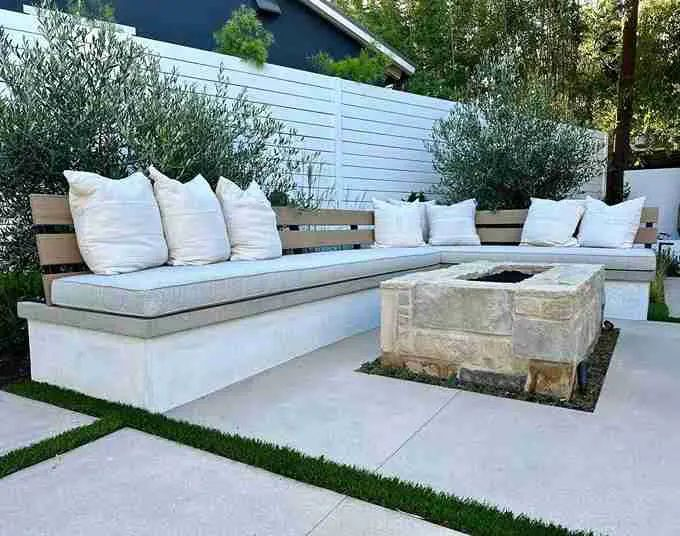
Creating a tranquil retreat starts with intentional material choices. A polished concrete pad provides the perfect base for a serene Zen-inspired nook—blending reflective surfaces, calming symmetry, and natural textures. The smooth finish enhances light flow and balances earthy accents like bamboo, river stones, or sand gardens.
This type of seating area benefits from minimalism. Low-profile benches or floor cushions invite stillness without visual noise. The concrete pad acts as an anchor, grounding the space both physically and symbolically. Embedded aggregates or soft gray tones contribute to the meditative vibe without overwhelming it.
Surrounding elements like vertical screens, potted grasses, or trickling water features can add rhythm and privacy. Subtle lighting or integrated candles enhance nighttime ambiance. Drainage should be accounted for through subtle slope or invisible seams, ensuring peace isn’t interrupted by puddles.
This nook isn’t just decorative—it offers a true sanctuary within the yard. Whether used for morning reflection, evening tea, or quiet conversation, the space promotes mindfulness. For homeowners looking to unplug and recharge, this design offers stillness without sacrificing elegance or permanence. The simplicity of concrete, when shaped intentionally, becomes more than structure—it becomes a setting for restoration.
